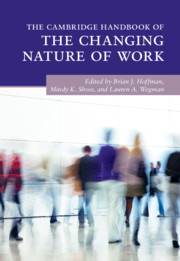Book contents
- The Cambridge Handbook of the Changing Nature of Work
- The Cambridge Handbook of the Changing Nature of Work
- Copyright page
- Contents
- Figures
- Tables
- Contributors
- Part I Introduction to the Changing Nature of Work
- Part II What Has Changed?
- Part III Implications for Talent Management and Impact on Employees
- Index
- References
Part II - What Has Changed?
Published online by Cambridge University Press: 02 April 2020
- The Cambridge Handbook of the Changing Nature of Work
- The Cambridge Handbook of the Changing Nature of Work
- Copyright page
- Contents
- Figures
- Tables
- Contributors
- Part I Introduction to the Changing Nature of Work
- Part II What Has Changed?
- Part III Implications for Talent Management and Impact on Employees
- Index
- References
Summary

- Type
- Chapter
- Information
- The Cambridge Handbook of the Changing Nature of Work , pp. 67 - 294Publisher: Cambridge University PressPrint publication year: 2020

